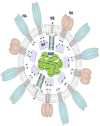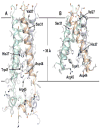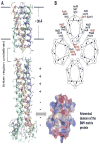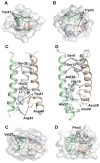Influenza M2 proton channels
- PMID: 20451491
- PMCID: PMC3108042
- DOI: 10.1016/j.bbamem.2010.04.015
Influenza M2 proton channels
Abstract
M2 of the influenza virus is an intriguing transmembrane protein that forms a minuscule proton channel in the viral envelope. Its recognized function is to equilibrate pH across the viral membrane during cell entry and across the trans-Golgi membrane of infected cells during viral maturation. It is vital for viral replication and it is a target for the anti-influenza drugs, amantadine and rimantadine. Recently, high resolution structures of M2 channels of both flu A and B have been obtained, providing the desperately needed structural details for understanding the mechanism of proton conductance. In particular, the establishment of the functional solution NMR system of the proton channels enabled simultaneous high resolution structure characterization and measurement of channel dynamics coupled to channel activity. This review summarizes our current understanding of how protons are conducted through the M2 channel from a structural point of view, as well as the modes by which important channel gating elements function during proton conduction.
2010 Elsevier B.V. All rights reserved.
Figures





Similar articles
-
Flu channel drug resistance: a tale of two sites.Protein Cell. 2010 Mar;1(3):246-58. doi: 10.1007/s13238-010-0025-y. Epub 2010 Feb 23. Protein Cell. 2010. PMID: 21203971 Free PMC article. Review.
-
Structure and dynamics of the proton-selective histidine and the gating tryptophan in an inward rectifying hybrid influenza B and A virus M2 proton channel.Phys Chem Chem Phys. 2024 Jul 31;26(30):20629-20644. doi: 10.1039/d4cp01648c. Phys Chem Chem Phys. 2024. PMID: 39037444 Free PMC article.
-
Protonation of histidine and histidine-tryptophan interaction in the activation of the M2 ion channel from influenza a virus.Biochemistry. 2001 May 22;40(20):6053-60. doi: 10.1021/bi0028441. Biochemistry. 2001. PMID: 11352741
-
Protonation equilibria and pore-opening structure of the dual-histidine influenza B virus M2 transmembrane proton channel from solid-state NMR.J Biol Chem. 2017 Oct 27;292(43):17876-17884. doi: 10.1074/jbc.M117.813998. Epub 2017 Sep 11. J Biol Chem. 2017. PMID: 28893910 Free PMC article.
-
Drug sensitivity, drug-resistant mutations, and structures of three conductance domains of viral porins.Biochim Biophys Acta. 2011 Feb;1808(2):538-46. doi: 10.1016/j.bbamem.2010.07.015. Epub 2010 Jul 23. Biochim Biophys Acta. 2011. PMID: 20655872 Free PMC article. Review.
Cited by
-
Promising strategy for developing mRNA-based universal influenza virus vaccine for human population, poultry, and pigs- focus on the bigger picture.Front Immunol. 2022 Oct 17;13:1025884. doi: 10.3389/fimmu.2022.1025884. eCollection 2022. Front Immunol. 2022. PMID: 36325349 Free PMC article. Review.
-
SV40 late protein VP4 forms toroidal pores to disrupt membranes for viral release.Biochemistry. 2013 Jun 4;52(22):3939-48. doi: 10.1021/bi400036z. Epub 2013 May 20. Biochemistry. 2013. PMID: 23651212 Free PMC article.
-
Influenza and Antibody-Dependent Cellular Cytotoxicity.Front Immunol. 2019 Jun 25;10:1457. doi: 10.3389/fimmu.2019.01457. eCollection 2019. Front Immunol. 2019. PMID: 31316510 Free PMC article. Review.
-
An Antigenic Thrift-Based Approach to Influenza Vaccine Design.Vaccines (Basel). 2021 Jun 16;9(6):657. doi: 10.3390/vaccines9060657. Vaccines (Basel). 2021. PMID: 34208489 Free PMC article. Review.
-
African Swine Fever Virus Gene B117L Encodes a Small Protein Endowed with Low-pH-Dependent Membrane Permeabilizing Activity.J Virol. 2023 Jun 29;97(6):e0035023. doi: 10.1128/jvi.00350-23. Epub 2023 May 22. J Virol. 2023. PMID: 37212688 Free PMC article.
References
-
- Palese P, Shaw ML. Orthomyxoviridae: the viruses and their replication. In: Knipe DM, Howley PM, editors. Fields virology. Williams & Wilkins; 2007.
Publication types
MeSH terms
Substances
Grants and funding
LinkOut - more resources
Full Text Sources
Other Literature Sources

